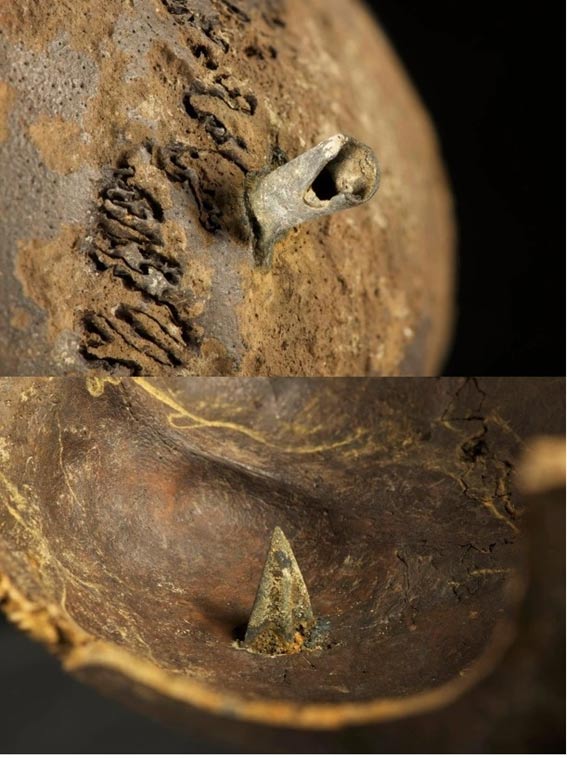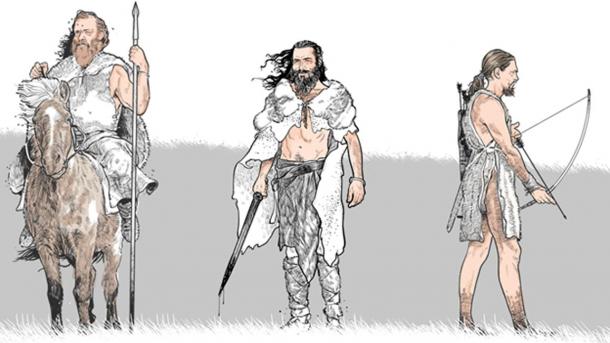
Unexpected and Gruesome Battle of 1250 BC Involved 4,000 Men from Across Northern Europe
A battlefield of 3,250 years ago in Germany is yielding remains of wounded warriors, wooden clubs, spear points, flint and bronze arrowheads and bronze knives and swords. The gruesome scene, frozen in time by peat, is unlike anything else from the Bronze Age in Northern Europe, where, researchers thought, large-scale warfare didn’t begin until later.
As it is, no one knows who these people were who fought on the banks of the Tollense River in northern Germany near the Baltic Sea because there are no written records from the time.

The Tollense River near the village Weltzin. (Public Domain)
But analysis of the remains of the 130 men, most between ages 20 and 30, found so far shows some may have been from hundreds of kilometers away—Poland, Holland, Scandinavia and Southern Europe.
The hand-to-hand combat of the battle, which may have involved thousands of people and may have taken place in just one day, was brutal, according to an article about archaeological research at the Tollense site in Science magazine. And it involved horses. Today, although the researchers believe they’ve unearthed just 2 to 3 percent of the battlefield, they have found the remains of the humans and of five horses.
- Not just about the booty: New study sheds light on reasons for Viking raids
- Scant Evidence that Early Prehistoric People were Warlike, Anthropologist claims
- Ten Diabolical Weapons and Strategies of War from the Ancient World
The victors stripped some bodies of their valuables, but others sank under the water and were eventually buried in peat moss.

Two gold rings detected in the Tollense valley (a: Weltzin 32, l. 2,9 cm. Photo J. Krüger; b: Weltzin 4, l. 3,1 cm. (S. Suhr, Landesamt für Kultur und Denkmalpflege)
There was no writing system then, so there was no way to record who these men were or why they were fighting. An old axiom says in the ancient world that there were three main reasons wars were fought: land, cattle, and women, but there is no way to tell the reason behind the bloodshed here.
The battlefield was discovered in 1996 by an amateur archaeologist, who saw an arm bone sticking out of the riverbank. Embedded in the bone was a flint arrowhead. Archaeologists did some minor digging there at the time and found a bashed-in skull and a wooden club of 73 cm (29 inches). Radiocarbon dating showed they were from around 1250 BC.

One of the finds from the site includes this human skull with a large fracture. (D. Jantzen/Never Yet Melted)
Between 2009 and 2015, researchers from the Mecklenburg-Vorpommern Department of Historic Preservation and the University of Greifswald found additional bones of horses and men, many of them grievously wounded. They also excavated wooden clubs, flint and bronze arrowheads and bronze spearheads.
They say there may be hundreds more men whose remains haven’t been excavated.

A skull that was found with a bronze arrowhead found firmly embedded into it, entering the brain. (Old European Culture)
“If our hypothesis is correct that all of the finds belong to the same event, we’re dealing with a conflict of a scale hitherto completely unknown north of the Alps,” excavation co-director Thomas Terberger, an archaeologist with the Lower Saxony State Service for Cultural Heritage in Hanover, told Science. “There’s nothing to compare it to.”
Science magazine adds that the battle may be the earliest direct evidence of a battle of this magnitude in the entire ancient world.
- War was central to Europe’s first civilisation – contrary to popular belief
- Earliest War Grave Found with 27 Slain People Dates Back 10,000 Years
- Debate continues over whether Stone Age people were peaceful or warlike
Previously researchers theorized there was raiding by young men to steal food and kill, but the carnage, stretching along 3 kilometers (1.86 miles) of the river, surprised the researchers. From the size of the site and remains found so far, they estimate there may have been 4,000 people involved in the battle.
This points to a warrior class and participation in war across Europe—previously unheard of, Science says. There are historical descriptions of Bronze Age epic battles from the Near East and Greece, but there has been little archaeological evidence found of any large-scale battles. And there are of course no written records from Northern Europe from the time.

Artist’s depiction of how warriors were equipped for the battle. (Science Mag)
“When it comes to the Bronze Age, we’ve been missing a smoking gun, where we have a battlefield and dead people and weapons all together,” University College Dublin archaeologist Barry Molloy told Science. “This is that smoking gun. Even in Egypt, despite hearing many tales of war, we never find such substantial archaeological evidence of its participants and victims.”
Anthropologist R. Brian Ferguson of Rutgers University, told Ancient Origins in 2015 that his research shows there was mostly peace in Europe and the Near East during a large part of the Stone Age, but war swept Europe and the Near East by the time of the late Neolithic (the most recent period of the Stone Age, 8000 to 3500 BC), and the Copper and Bronze ages beginning about the sixth to fifth millennium BC. Go back several millennia BC “and war is not evident,” he said.
Ferguson said the presence of war in a prehistoric society may be studied by looking at artistic prehistoric representations of combat or homicide; presence of weapons; evidence of fortifications in layers now buried in the earth; and skeletons showing wounds.


Two wooden clubs found at the site. (Old European Culture)
Featured Image: Excavation of an ancient battlefield in northern Germany revealed signs of an immense battle, such as closely packed bones, as seen in this 2013 photo of the site. One area of 12 square meters is said to have held 1478 bones, including 20 skulls. Source: Landesamt für Kultur und Denkmalpflege Mecklenburg-Vorpommern/Landesarchäologie/C. Harte-Reiter
By Mark Miller
















Comments
Yes, it is good to fight a battle with staunch companions. The choice is Wilkins site, very well worked out and Vinci's postulation of Finland. Others objecting to Troy in Finland have no real alternative, so that the Baltic Odyssey and British Troy make a good combination.
My interest now, as with finding the basis of all propaganda, is finding where the PC ideas originate. The development of cognitive dissonance among historians is interesting and amusing (but worrying).
Earlier questioners such as LA Waddell and Comyns Beaumont were limited by the lack of data. Potentially we are overloaded. Answers are sequestered in the bowels of museums, just needs the right people, like Robert Temple -The Crystal Sun, to see what others cannot. If I had continued my mineralogy career I had plans of bronze analyses to find the origins of the tin in the bronze age. Perhaps this is now being done. I am out of touch. Once the anti-diffusionists get a reaming then the expansion of theories to proven facts will revolutionise world history. But with the degenerates of the NWO in control I am not holding my breath.
As a publisher in Australia I see ignorant university trained degenerates lying to keep their revolutionary credentials shining. There is a definition of this in polishing ones scat etc.
Yes, I have read that book long ago, but not the second edition. However Vinci's book is more convincing (pun?). Plutarch and Strabo etc indicate the north for the locale. I think that the English Troy maybe a new Troy, after the original site. The old name of London was Nova Troy(see the Bruts of England) and QEI was later called the Trojan Queen. The Odyssey is absolutely in the Baltic and North Sea but Troy's (The Iliad) location is still debatable, England or Finland etc. Obviously there is a folk memory in Western Europe. The jury is still out, but we absolutely agree that the gatekeepers are 'way out.' The more one examines the absolutes of their 'histories' the inevitable conclusion that they are insane is solidly reinforced. Just like those who think that the arabs did 9/11, London etc.
Better, read Wilkens “Where Troy Stood.” The battle was circa 1200 BC near Cambridge, England. All the river names of the Iliad (some exact, some slightly transformed) are yet in England, the geographical features, the weather patterns, the tide patterns, the animals (e.g., the eels), the huge war dikes still stand south of Cambridge built to protect the “Greek” camp, the bay with shore area needed to beach the 1200 ships needed for transport of an army, from yes, again, “all over Europe.” Per the Iliad, 50,000 to 60,000 fought on each side, over 10 years, involving eventually over 1 million men. It was fought over control of the tin trade – the essential ingredient in bronze – with the copper coming from the mines on the Lake Superior shore. For the archeologists to be “surprised” over finding a battle site on the scale of 4000 men circa 1250 BC is reflective of their utter failure to grasp the nature and scope of the battle of Troy, their refusing to truly believe the Iliad’s account, and their complete hoodwinking by the fraud, Schliemann.
Thank you. Yes I have read that. The other non existent(?) title threw me.
He is a Welsh historian. Here is a link to one of his books https://www.amazon.co.uk/Holy-Kingdom-Quest-Real-Arthur/dp/0593040627/re...
Pages